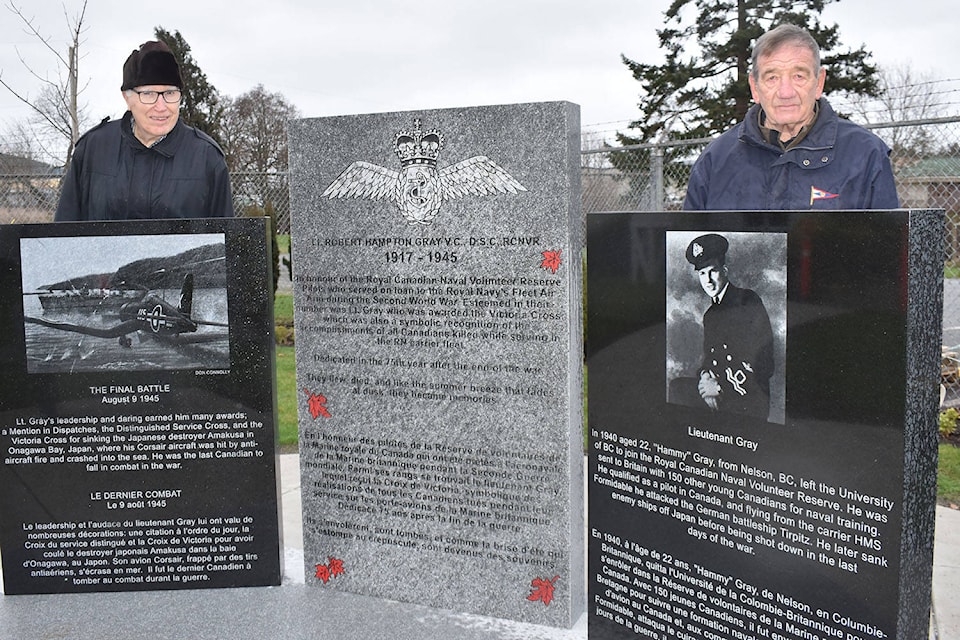“Hammy” was 28 when he a led an attack of eight Corsair aircrafts on a convoy of Japanese naval vessels in Onagawa Bay near Tokyo on Honshu Island, the largest and most populous of the Japanese Islands.
Flying off the HMS Formidable aircraft carrier, Lieut. Robert Hampton Gray was a long way away from Nelson, where he grew up, and his studies at the University of British Columbia, where he was a student when war broke out in Europe.
Desperate for personnel, the Royal Navy trained Gray as a pilot in both England and Canada after he had volunteered for the war through the Royal Canadian Naval Volunteer Reserve as an ordinary seaman.
His active duty with the Royal Navy’s Fleet Air Arm took him to several theatres of the war, including Africa and the Atlantic, where his performance in the HMS Formidable attack on the German battleship Tirpitz anchored in a Norwegian fjord earned him a mention in the official dispatches by his superiors to headquarters. That was in late August 1944.
Less than a year later, the HMS Formidable found herself off the Japanese main island after the vessel had withstood a Kamikaze attack during the Battle of Okinawa in the spring of 1945. During the attack on the Japanese vessels in Onagawa Bay, anti-aircraft fire hit Gray’s plane as it attacked the destroyer Amakusa.
With his plane burning, Gray still released the bomb carried by his plane, hitting and sinking the destroyer, before crashing in the bay.
RELATED: North Saanich’s B.C. Aviation Museum helps preserve physical legacy of Second World War
The date of Gray’s death was Aug. 9, 1945. Six days later, Japanese Emperor Hirohito announced Japan’s surrender to Allied forces, formalized on Sept. 2.
This timing means that Gray was among the last Canadians killed during the Second World War and the last Canadian to win the Victoria Cross.
His collection of medals, which also includes the Distinguished Service Cross for helping to sink another Japanese destroyer in July 1945, makes Gray the most highly decorated pilot from British Columbia, a history now recognized at North Saanich’s BC Aviation Museum with a three-piece monument following a campaign led by a group of former navy members and members of the Naval Association of Canada that raised $100,000.
The monument itself consists of two black pillars of granite flanking a central pillar of gray polished granite. The right pillar features the last picture of Gray in his lieutenant’s uniform, while the left pillar features an artist’s rendering of Gray’s final attack. The central pillar records Gray’s title, awards, decorations and history for visitors to the museum.
Project manager Terry Milne, who was also Canada’s former naval attache to Japan, said organizers chose the museum because of its subject, Gray’s origin from British Columbia and its proximity to the provincial capital. “And of course, we have the navy base here and the naval squadron on Victoria Airport as well,” he said.
The monument — which will be dedicated after COVID-19 restrictions have eased — is not the only monument of its kind.
RELATED:Ambitious B.C. Aviation Museum need $10M to get iconic Lancaster back in the air
Described as a unique gesture of compassion and reconciliation, former Canadian and Japanese veterans dedicated a monument to Gray in 1989 on a hill overlooking the bay where his remains still lie.
Milne notes that the monument, while explicitly recognizing Gray, also draws attention to 260 Canadians who served in the Royal Navy’s Fleet Air Arm. “Of these, 46 were killed, ” he said. “They were not only pilots, they were also engineers, flight crew, and so on.”
Since officials could not hand out Victoria Crosses en masse to these 46 Canadians, Gray’s commanding officer also said that “they would like the award to also be a symbolic, though secondary, recognition for all Canadians killed, some 46 of them, for which they had no other award that they could give them,” said Milne.
“This is recorded on the monument itself.”
For more news from Vancouver Island and beyond delivered daily into your inbox, please click here.
Do you have a story tip? Email: vnc.editorial@blackpress.ca.
Follow us on Twitter and Instagram, and like us on Facebook.
